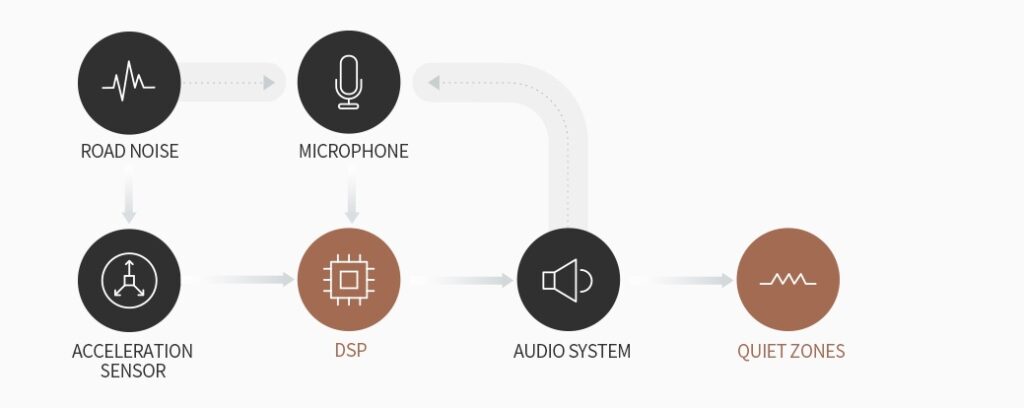Active noise cancellation or ANC technology: the secret sauce for in-cabin comfort

ANC technology helps improve in-cabin comfort. In this article, we share insights into reducing the perceived level of powertrain and road noise. It also explains how to benefit from the move toward software-based acoustics.
In-cabin noise issues used to be solved by thickening the glass on the windows and windshields or providing sufficient damping material between the cabin interior and exterior. With lightweight strategies and fuel efficiency as the driving force behind vehicle development, other technologies are required to ensure noise doesn’t propagate into the cabin.
There are several noise sources in a car. The most prominent noise sources are; road noise, wind noise, powertrain noise, and ancillary noises from cooling fans, HVAC, or other components.

With internal combustion engines, manufacturers traditionally optimized the engine mounting and body structure to minimize noise. More and more, they also added artificial sound to mask, modify or enhance the engine noise. But the powertrain no longer dominates the sound of next-generation cars. External noise, such as road and wind noise, influences the driver’s comfort in electrified vehicles. Contrary to adding sound to the vehicle, customers might prefer the sound of silence in some situations.
Today, manufacturers find an elegant solution in vehicle active noise cancellation. ANC technology helps to improve in-cabin comfort and reduce materials cost while keeping the vehicle weight at a minimum.
Hyundai’s quest for a quieter ride
Almost two years ago, Hyundai revealed its Road Noise Active Noise Control (RANC) system for a quieter ride. See article: Hyundai’s World’s First Road-Noise Active Noise Control, RANC. The manufacturer foresees that cabin silence and NVH comfort will be one of the decisive buying factors.
Road noise ANC technology takes existing NVH performance to the next level.
Gangdeok Lee, Research Fellow of NVH Research Lab at Hyundai Motor Group
What is ANC technology, and how does it work?
ANC technology detects unwanted noise and canceling it with signals broadcasted through the car’s audio system. It improves the driving experience. Extra bonus: they significantly reduce vehicle weight.
The Siemens broadband ANC technology has been designed to tackle engine and road noise. It leverages active noise cancellation and gains maximum advantage from the move toward software-based acoustics.
Road-noise ANC technology works by having active devices, such as speakers. They generate an anti-wave or inverted wave to the original sound wave, the noise source. The generated inverted wave is identical in amplitude and frequency to the noise source but is inverted (i.e., 180 degrees out of phase). When the original wave and this generated inverted wave come together in the cabin, they cancel each other – resulting in a quieter cabin ambiance.

Where is the catch?
Coordination between a few components is essential to arrive at a point where the electronics in the car can generate the anti-noise spectrum:
- Microphones and accelerometers: to record and analyze the wave pattern of the original wave that needs to be canceled. Next, the digital signal processor analyzes the recording of the wave.
- Digital Signal Processor (DSP): The DSP analyzes the noise captured by the mics and accelerometers. It sends out the output provided by the ANC algorithm running on the DSP.
- ANC Algorithm: to generate the anti-noise pattern. A good ANC algorithm needs to be small and fast for best results.
- Speakers: to output the anti-noise signals, cancel out the noise generated by the noise sources.
What’s the secret sauce of ANC technology?
On the surface, this looks very straightforward. Still, if we look deeper, it takes many studies to understand the ideal placement locations for the microphones, accelerometers, and speakers to achieve the best results. To achieve the best results for ANC, Siemens works with OEMs to identify the best locations for sensor placement. This has been possible with our software tools developed just for this purpose and experience from past production systems.
>> Read the white paper: Improve in-cabin vehicle acoustics using active noise cancellation technology
ANC technology footprint on the processor
Over the years, Siemens has enhanced the ANC algorithm. It occupies a tiny compute and memory footprint on the processor while achieving the best possible noise cancellation results. The broadband algorithm can cancel both lower and higher frequency noises with the same algorithm. The lower frequency noise cancellation usually addresses engine noise. Higher frequency noise cancellation cancels road noise. Deployed in the car, this broadband algorithm creates a comfortable cabin for all occupants.
What does the future hold?
The commercial adoption of ANC technology accelerated due to a number of factors; the availability of powerful processors and sensors at an affordable cost, software algorithms, modern tuning techniques for sensor placement, and the market trend towards rapid integration of these components in the vehicle. Automakers strive to offer new features. But, they also want to keep the vehicle weight low. Using active methods plays a vital part in reducing NVH and improving the in-cabin experience.
When self-driving and autonomous cars become more common, future cars will be a space where people can multi-task, hold meetings, relax, enjoy music, or have a quick nap. The quietness offered by ANC technology will be essential for passenger comfort of today’s and tomorrow’s vehicles.
A vehicle sound: the expression of a brand personality
Sound enhancement techniques help control all noise sources by inducing sound into the vehicle through the infotainment system. In this article, we focused on ANC technology to cancel out unwanted noise sources.
Another approach impacting the overall sound experience is Active Sound Design. Active sound design (ASD) is a methodology that generates meaningful sounds for replaying in the car (internal or external). This adds driving emotion to the interior sound ensures pedestrians’ safety. Read the blog “All you need to know about vehicle active sound design” to discover how to implement active sounds in the vehicle.
Discover all Simcenter NVH & Acoustic solutions by visiting the website NVH & Acoustics of Electrified vehicles.


